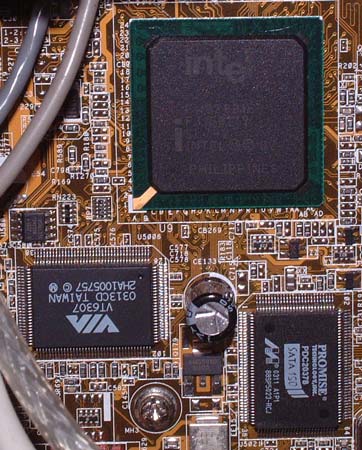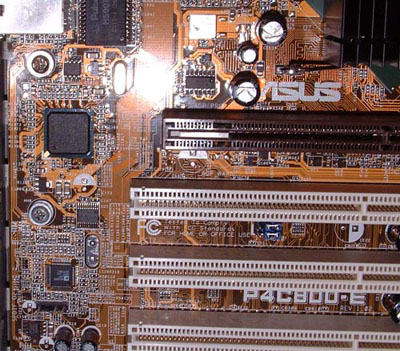Asus P4C800-E: Updating the Intel Flagship
by Wesley Fink on August 30, 2003 10:55 PM EST- Posted in
- Motherboards
Asus P4C800-E: Basic Features
| Motherboard Specifications | |
| CPU Interface | Socket-478 |
| Chipset | Intel 82875P MCH (North Bridge) Intel 82801ER ICH5R (South Bridge) |
| Bus Speeds | up to 400 MHz (in 1MHz increments) |
| Core Voltages Supported | up to 1.95V (in 0.0125V increments to 1.60V, 0.025V increments 1.6 to 1.95V) |
| AGP VDDQ Voltages Supported | 1.5 to 1.8V (0.1V increments) |
| DRAM Voltages Supported | up to 2.85V (in 0.1V increments) |
| Memory Slots | 4 x 184-pin DDR DIMM Slots |
| Expansion Slots | 1 AGP 8X Slot 5 PCI Slots |
| Onboard RAID | Intel ICH5R Southbridge Promise PDC20378 Controller |
| Onboard USB 2.0/IEEE-1394 | Eight USB 2.0 supported through South Bridge VT6307 IEEE-1394 FireWire Controller |
| Onboard LAN | Intel PRO1000 CSA GigaLAN (CSA bus) |
| Onboard Audio | Analog Devices AD1985 Controller |
| Onboard Serial ATA | Two SATA connectors via Promise PDC20378 Controller Two SATA connectors via ICH5R (Intel SATA RAID 0,1 or non-RAID) |
| BIOS Revision | 1.010 |
The basic features of the P4C800 Deluxe are described in the earlier review of the P4C800 Deluxe. Changes from the original P4C800 Deluxe are indicated in bold print. Asus has made many changes to the adjustment ranges in the BIOS. These BIOS changes also apply to the P4C800 Deluxe.

The P4C800-E Deluxe replaces the Intel ICH5 with the ICH5R. This adds the capability of Intel SATA RAID in addition to SATA RAID provided by the on-board Promise controller. With recent updates to the BIOS and Intel RAID drivers, the P4C800-E can support both Raid 0 (striping for performance) and Raid 1 (mirroring for security).

Intel’s CSA Gigabit LAN replaces 3Com on the “E” revision. This PRO1000 chipset moves LAN off the PCI bus and provides communication with the chipset and CPU on a dedicated communications bus.










30 Comments
View All Comments
Anonymous User - Sunday, August 31, 2003 - link
So, then running 4 DIMMs of Corsair XMS LL Platinum 512 MB would be slower than just 2 DIMMs of that memory? Is it just PAT that is affected? I've heard that this board will slow the latency timings and drop out of dual-channel mode with 4 DIMMS. BTW, I heard this from a rich friend who bought a system from Falcon Northwest and asked them about using 4 DIMMs on this exact board. They said that it would slow the latency timings and drop out of dual-channel. Was this experienced during testing? Is it that Falcon Northwest doesn't know what they're talking about? Now I am very confused about this particular board.Wesley Fink - Sunday, August 31, 2003 - link
Asus SAYS the P4C800-E is compatible with Prescott, but without a Prescott chip to test with we can not give a definitive answer.We did in fact run several benchmarks comparing the old and new when we began the memory testing for our DDR500 review, but found no real difference in performance between the old and new with both running 1.010 BIOS. That is why we did not publish performance tests comparing the two, and we stated there was no performance difference in our update. We did find memory compatibility better on the "E" and also reported that as well.
DrMrLordX - Sunday, August 31, 2003 - link
I second the request for information about this board's compatibility with Prescott.Anonymous User - Sunday, August 31, 2003 - link
Jesus Christ, how can Anandtech readers be so stupid. Both the old and new ASUS revision are based on the EXACT SAME CHIPSET! It would be ridiculous to compare them, they both use the 875P chipset, the only difference is a couple onboard features that make the newer revision a better overall board and value.Christ, READ the reviews for god sakes.
PrinceGaz - Sunday, August 31, 2003 - link
I feel #3 had a very good point. Since it is a review which begins by comparing the old revision with the new one, not including both in the benchmarks was a mistake (assuming the figures are available).@#4: Telling everyone to go and compare the results from an older review is crazy; for the time it would take for them to be included, asking everyone who reads the review to go and read another simultaneously is stupid.
Anonymous User - Sunday, August 31, 2003 - link
#4Catch a clue. Go read the old review and compare them.
Anonymous User - Sunday, August 31, 2003 - link
So, why the heck did you not bench the old against the new. That is after all what all the bloody writing ia about. That should include a lan test. Get on it, do it. What a waste, waste, waste. Oh yea....what kind of memory can you use with the old revision?Useless information is everywhere.
Anonymous User - Sunday, August 31, 2003 - link
Outstanding review! What I'm missing though is information about the support for the Intel Prescott processor. Looking on the ASUS website and in the manual, it is stated that it is compatible but such claims have been made for other motherboards only to be withdrawn later. Is it compatible with FMB 1.5 and VIN 1.5 required for the Prescott?I'm also quite surprized that PAT is disabled if you have 4 DS dimms running at FSB bus speeds higher than 200Mhz. After reading "Searching for the Memory Holy Grail: Part 1", I had planned to go for 4 256MB Cosair TwinMX dimms instead of 2 512MB ones. I'm eagerly awaiting the answer you get from ASUS.
Cheers,
Manuel
Wesley Fink - Sunday, August 31, 2003 - link
Since this was an update to an earlier review, we did not cover features that would be discussed in a full review. However, I have tested AI overclocking on the P4C800-E and find it works very well.You set the desired overclock, and the boards adjusts all parameters for the most stable overclcoking performance. Overclocks up to 30% (around 1066 FSB) are possible using AI.
Anonymous User - Sunday, August 31, 2003 - link
Would Like to know if you tested the much vaunted "Artificial Intelligence" overclocking ability of this board. This is something that mere mortals are very likely to use, rather than all the tinkering with FSB speeds and memory timing.